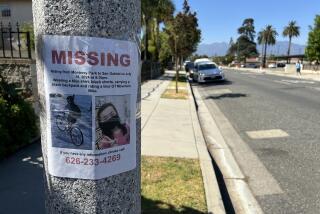Urgent Need for More Licensed Child Care Cited
An extensive study has found an urgent need for more licensed child care throughout Los Angeles County--and revealed that only a handful of in-home programs and day-care centers are accredited, suggesting some children may not be receiving the brain-stimulating experiences they need for healthy development.
Countywide, an additional 200,000 licensed spaces are needed for school-age children and more than 100,000 for infants from age 6 weeks to 2 years, according to the Los Angeles County Child Care Needs Assessment study, to be considered Tuesday by the Board of Supervisors.
The report also found:
* Deficiencies vary depending on the community. Some areas need more infant care while others need more space for preschool children.
* Low-income areas, particularly Latino communities, have the most severe shortage of affordable day care.
* More than 100,000 children are on waiting lists for subsidized care.
* Additional financial assistance is needed to help low-income working families obtain licensed child care.
“There are a lot of sorely neglected low-income working families who need child care,” said Laura Escobedo of the Child Care Resource Center in Van Nuys, which refers parents to licensed providers and dispenses subsidies to eligible families.
“We have a lot of families that are in a real bind. Maybe they’re making $20,000. They can’t take $500 to $600 [a month] out for child care.”
More Space for Infants Among Suggestions
To alleviate the situation, the Child Care Planning Committee’s report recommends more space for infants, increased funding for subsidized infant care, and easing the process for building new day-care facilities.
The study also recommended improving training for child-care workers and increasing their hourly wages, which average between $7.24 and $12.19. Exactly how much this would cost was not specified in the report.
Supervisor Zev Yaroslavsky said Friday the dearth of licensed child care is not surprising considering all the mothers who have traded a welfare check for a paycheck.
“It’s very much part and parcel of our own welfare implementation,” he said. “In the short run, money [for child care] isn’t the problem. The bigger challenge is to get qualified child-care facilities and providers in amounts that would meet the demand that welfare reform requires.”
The report, to be completed every five years, was required as part of AB 1542, the landmark welfare reform bill that was signed by Gov. Pete Wilson in 1997. It was funded through the state Department of Education and took a year to complete.
Eight geographic areas of the county were studied. Among the specific findings:
* The San Fernando, Santa Clarita and San Gabriel valleys have the greatest need for infant care.
* Downtown, West Hollywood and East Los Angeles have severe shortages of both infant and preschool care.
* The pervasive poverty in South-Central Los Angeles undermines the expansion of services while relatively affluent communities on the Westside struggle to meet the needs of working low-income families.
Some families are on long waiting lists for government child-care subsidies. Others earn annual incomes barely over the state limit of $37,608, making them ineligible for government programs, yet unable to afford licensed child care. Instead, their children generally are watched by neighbors, family members or perhaps parents who work opposite shifts.
Despite an apparent need for more child care, research showed that child-care centers countywide have 17% vacancy rates and in-home programs have a 25% vacancy rate.
The main reason for this discrepancy is the affordability of child care, said Kathy Malaske-Samu, county child-care coordinator who wrote the report. Many low-income working families can’t afford to pay for child care that averages $105 a week in the San Fernando Valley, and those with higher incomes can afford to be picky.
“Quality plays a role in it,” Malaske-Samu said. “When you have the money to purchase care, you have some expectations.”
In a random survey by The Times of 21 licensed in-home child-care programs in the San Fernando Valley, known as family day-care providers, 11 currently have space, mostly for children 2 years and older. Nighttime and weekend care is available at only three sites.
Indeed, when a representative of the National Assn. of Family Child Care inspected 16 homes six months ago for accreditation, all homes visited had space available.
“[The shortage in the Valley] really sounds large to me,” said Bernice Gilmore, regional representative for the NAFCC and licensed to care for 14 children in her Inglewood home. “The providers I’ve observed in the Valley weren’t at full capacity.”
Quality of Child Care Is Given Attention
The committee estimated the demand for licensed care based on the number of mothers working and the number of people participating in the welfare reform program known as California Work Opportunity and Responsibility to Kids, or CalWORKs. The committee could not determine whether the families whose children are watched by relatives or neighbors do so by choice or because licensed services are unavailable or unaffordable.
Officials also looked at the quality of child-care programs. Few have received accreditation by outside organizations, which focus on education and enrichment and is separate from the licensing process, which is concerned with health and safety issues.
The National Assn. for the Education of Young Children has accredited 555 child-care centers and preschools in California. Eighty-three are in Los Angeles County, including 35 in the San Fernando Valley, one in the Santa Clarita Valley and three in the Antelope Valley.
There are far fewer accredited in-home programs. The NAFCC has accredited 86 in-home providers in California. Four are in Los Angeles County, with three in the San Fernando Valley and one in Los Angeles.
Few family day-care programs are accredited, according to the NAFCC, because providers are unaware of the process and parents don’t demand it. Providers must pay a $500 fee every three years to become accredited.
All three of the Valley’s accredited in-home providers are affiliated with Mission College’s Family Child Care Homes Network, a state-funded program for low-income students and workers that subsidizes child care for children up to age 3. Twenty-eight providers connected with the network are either pursuing or have completed accreditation.
Mary Burnett, quality control specialist and site supervisor for the program, says Mission College encourages accreditation because it makes for better child care.
“It’s a pretty scary thought because these are our children,” Burnett said. “[The providers] are licensed but no one is really monitoring them, saying things like, ‘These are the games you can be playing for different age groups and this is how you can accommodate different age groups.’ ”
Blanca Ibanez and Beverly Ysais, who run in-home child-care programs in Sylmar, became accredited this year.
Ibanez teaches the alphabet to children in a bright, cheery room she added on to her house.
Ysais said she “gets them completely ready for school” by reading the kids books, teaching them the names of colors and even American Sign Language.
“This is the most awesome thing, to be the one to teach them,” said Ysais, who has been providing day care since 1985.
Times staff writer Sarah Torribio-Bond contributed to this story.
(BEGIN TEXT OF INFOBOX / INFOGRAPHIC)
Child-Care Shortfall
A countywide child-care study found a substantial lack of licensed providers, especially those who care for infants. The Board of Supervisors will consider the report Tuesday.
*
Source: L.A. County Child Care Planning Committee
More to Read
Sign up for Essential California
The most important California stories and recommendations in your inbox every morning.
You may occasionally receive promotional content from the Los Angeles Times.






